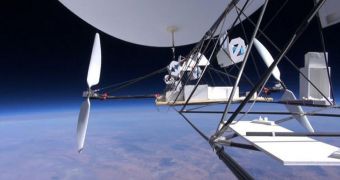A DIY space program recently managed to smash all world altitude records, by sending a drone aircraft flying about 18 miles (30 kilometers) above the surface of the planet. The company is considering the creation of balloon-borne, manned waypoint stations in Earth's atmosphere.
These installations will be used by astronauts seeking to make their way into space. This two-step approach would significantly cut current costs associated with putting humans and cargo in orbit.
The new flight took place on October 22, with the airship Tandem. The drone was able to raise about 4 miles (6.4 kilometers) higher than any previous airship ever could, thus establishing a new world record, Space reports.
The test flight took place over the Black Rock desert, in Nevada, the United States. The drone was able to reach an altitude of 95,085 feet (28,982 meters) above the planetary surface, demonstrating that the Airship to Orbit program is indeed possible.
JP Aerospace is trying to develop this program so that astronauts could be flown to space cheaply and safely, using nothing but existing technologies. This announcement was made by the company's president, John Powell.
“The big aerospace firms have been trying to do this for decades, spending hundreds of millions of dollars. We've spent about $30,000 and the past five years developing Tandem,” the official explains.
He adds that the most important component of Tandem is a 30-foot (9-meter) carbon fiber truss, which runs transversally through the aircraft. A large balloon is located at each of the two tips, providing Tandem with lift it needs to soar up in the sky.
The airships also features improved propeller designs, which enable it to function properly even as high as 20 miles (32.2 kilometers). The 6-foot (1.8-meter) propellers are driven by two electric motors. But the unmanned drone does not rely exclusively on these means to return to home safely.
The two balloons can be separated from Tandem's body, and the remaining of the airplane can descend to Earth affixed to five parachutes. This ensures that the same airship can be used over and over again.
“This new way to space has not and will not require a massive pile of capital to accomplish. Each component has its own business application and funding source. It is a pay-as-you-go system,” a statement from JP Aerospace reads.
In the near future, the Airship to Orbit program will extend, leading to the creation of a large airship capable of flying as high as 27 miles (43 kilometers) above the surface. Such an aircraft could take up to 3 astronauts high above the planet.

 14 DAY TRIAL //
14 DAY TRIAL //